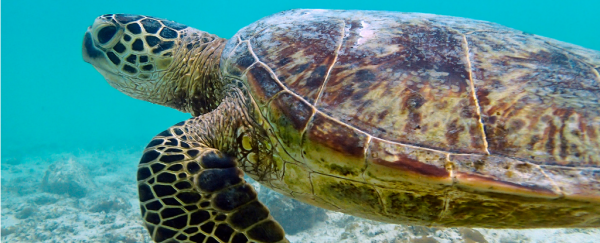Fishing nets kill thousands of sea turtles every year, and every death is a hard blow, since most sea turtle species are endangered. A new study from the University of Exeter, however, is floating a solution that might help save countless numbers of the shelled reptiles. And it's actually very simple. Scientists added green, low-power lights to the fishing nets that pose the biggest risk to sea turtle populations.
The study's authors found that the LED lights can save up to 64 percent of the sea turtles caught in gillnets, a kind of fishing net strung across the sea floor like a tennis net. "The turtle populations in the eastern Pacific are among the world's most vulnerable and we are hoping that reducing bycatch, particularly in gillnets, will help with the management and eventual recovery of these populations," said lead researcher Jeffrey Mangel in a statement.
Scientists and conservation organisations like the World Wildlife Fund use the word 'bycatch' when fisheries catch turtles unintentionally, using this or other fishing methods.
The holes in the net are big enough for the target fish to get their heads through, but not the rest of their bodies. When turtles get tangled in the nets, they can drown. Even if they manage to make it to the surface, though, they may be fatally injured — the nylon strings cut into the soft tissue around their neck or fins.
The lights are also inexpensive. At only $2 per unit, the researchers estimate that it only costs $34 to save one turtle. They note that large-scale implementation could drive the cost down even further.
Using 114 pairs of gillnets off the coast of Peru, scientists placed the LEDs every 32 feet (10 metres) along a 547-yard (500 metre) net. They found that nets without the lights caught 125 turtles, while the illuminated nets only caught 64.
"The idea of using lights comes from asking how we can change the behaviour of animals," Mangel wrote in an email to Tech Insider. The idea is similar to acoustic warnings, or 'pingers', that researchers have found effective in deterring dolphins and porpoises from fishing nets.
While Mangel said it was challenging to nail down exactly what it is about the lights that warns the turtles away from the nets, he speculated that the light may make the nets more visible, making them easier for the turtles to avoid.
An added benefit is that guitarfish, the species the fisheries are actually targeting, can't see the green light - it's outside the spectrum of colour the fish can see.
Wide-scale adoption by fishermen could go a long way. In 2013, marine biologist Bryan Wallace wrote in The Huffington Post that there are an estimated 62,000 miles (99,779 km) of gillnets in the waters off the Peruvian coast.
Next, Mangel said, the team is now experimenting with different coloured lights that might warn away other endangered species while preserving catch quantities for the fishermen. He's particularly interested in working with fisheries that commonly (and unintentionally) catch seabirds and smaller dolphins, porpoises, and whales.
Given that scientists estimate we lose at least several thousand species each year, solutions like these - innovative, cheap, and effective - are a bright spot in the battle to stave off rapidly disappearing biodiversity.
This article was originally published by Business Insider.
More from Business Insider:
